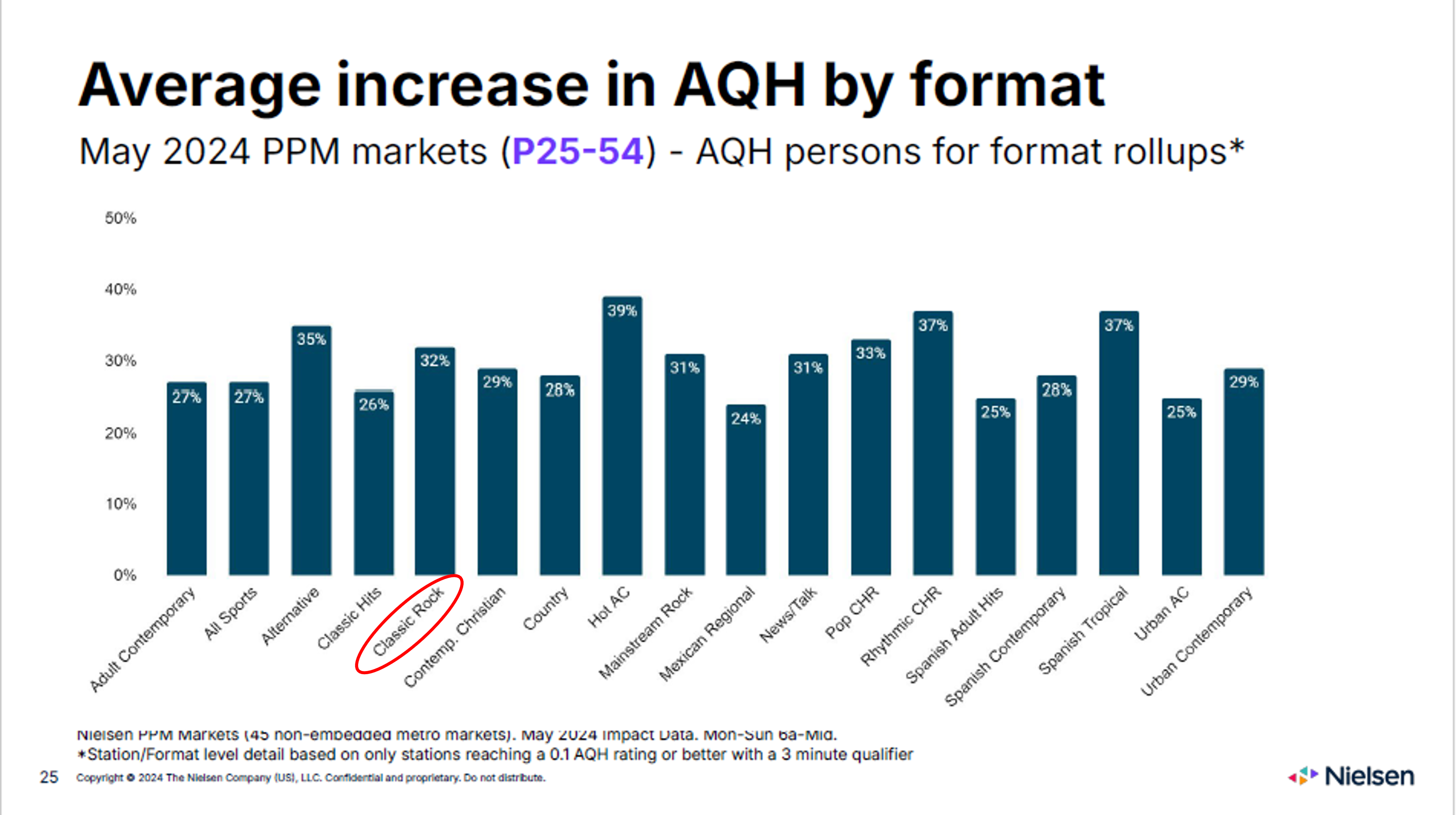
In an otherwise lackluster, even disappointing year in radio, there is something very fortuitous and potentially even wonderful on the horizon. And for that, radio operators will have Nielsen to thank.
Now that may seem counter-intuitive. After all, very little good news ever seems to emanate from “the ratings company of record.” Whether it’s Arbitron, Nielsen, or a ratings company to be named later, radio broadcasters have long considered the company that supplies what’s known as “ratings currency” similarly to how most of us regard the IRS – a necessary evil that takes boxcars filled with money in exchange for numbers that are often dissatisfying at best.
Now to the hard-working, well-meaning people who tirelessly try to keep the ratings system balanced and equitable, this treatment is hardly fair. Most of them worked in the radio business at one time or another, so they feel our pain.
But this year end could be different, with the promise of wrapped presents sitting under the tree from Nielsen, filled with good tidings, and more importantly, better ratings for all. At least, that’s the hope. In a webinar hosted by the Nielsen Audio team yesterday, a new ratings plan for PPM markets was unveiled. And even though it sounded like a bunch of political promises in an election year, the fact is, the new Nielsen “3 Minute Plan” ought to deliver on the promise.
In case you somehow missed it – and the ratings company has been in close touch with its radio clients for months – Nielsen is proposing to sweeten up the formula that awards those all-important quarter-hour credits to stations. For the past 100 years (seriously), the hard and fast rule required 5 minutes of listening (not contiguous) to a radio station in order to receive a quarter-hour credit. But in this age of virtually infinite choice, deteriorating attention spans, and short songs that are three minutes in duration or less, radio stations have gotten screwed out of quarter-hours racking up on their side of the ledger.
I won’t go into the insidious ways stations can lose their grip on quarter-hours during the course of a listening span, but they are numerous and they’re painful. In fact, Nielsen explained during yesterday’s webinar that nearly HALF of all radio listening occasions come up short for quarter-hour credit because they are less than five minutes in duration. And you wonder why radio programmers often appear to be unstable and develop nervous tics.
But now a rule’s change would alleviate much of this pain and suffering. That’s because the 5-minute requirement is being reduced to 3 minutes. And while this may not sound like a major change, Nielsen’s actual numbers recalculated to this new standard generates an average AQH increase of 26% in the total 6+ population.
That’s not a typo. It’s not 2.6% (although even that would be a welcome boost right about now).
It’s TWENTY-SIX FREAKING PERCENT!!
Nielsen spent the rest of the webinar slicing and dicing the numbers – by age demographic, by format, and by market. And it’s ALL GOOD. As Oprah might say, “Everybody gets higher ratings!”
Pretty much. And in a nasty world where there is higher AQH listening in old school, Neanderthal paper diaries than there is with those sleek meters, Nielsen’s proposed rules change was welcome news to radio broadcasters who have been whining about PPM for the past 17 years.
Notice I used the word “proposed.” Because as Nielsen Audio chieftain Rich Tunkel reminded the assembled Zoom-sters, radio broadcasters have some decisions to make. Do they really want to change the AQH crediting rules right now? And if so, when would they want “The 3 Minute Rule” to become the new law of Radioland?
I know. These are tough questions. To anticipate how these calls might go, I offer the following role playing example I completely made up:
Nielsen rep: “So what do you think? Do you really want to go through with this?”
Mr./Ms. radio broadcaster: “Ugh, I think so. But I have a couple questions.”
Nielsen rep: “Shoot.”
Mr./Ms. radio broadcaster: “Seriously, how much is this going to cost us? Or will the price increase be backloaded to the end of my contract so I can make it somebody else’s problem?”
Nielsen rep: “Not a shekel more. We just need to figure out the switch or two we’ll need to flip to get this going.”
Mr./Mrs. radio broadcaster: “You’re not going to cut back the sample size in my markets in order to pay for this new service, are you?”
Nielsen rep: “Not a chance. It’ll be the same everything, except for the adjustment you’ll likely have to make to deal with the idea of having much better ratings than you have now.”
Mr./Ms. radio broadcaster: “Will the book, the numbers, the measurement change?”
Nielsen rep: “Nope, same as it ever was; daily cume, weekly cume, daily AQH, weekly AQH, PUMM, you name it. It’ll all be there for your sellers and your clients.”
Mr./Ms. radio broadcaster: “Now tell me, how soon could we do this?”
Nielsen rep: “How soon do you want to do it? If you and your peers got moving, we might be able to get our plan together before Ryan Seacrest drops the ball in Times Square. Certainly, in Q1 2025. It just depends how eager you are to get considerably higher numbers for your beleaguered radio stations.”
Hopefully, this exercise prepares you for what promises to be a gritty exchange. You might even want to grab that copy of You Can Negotiate Anything that’s been gathering dust in your office in preparation for this tete-a-tete with your brutal Nielsen rep.
As the Nielsen team admitted on the webinar, they don’t exactly know how the voting will work. Will companies get one vote per station, sort of like the House of Representatives? Or will Bob Pittman and Bud Walters each get just one vote, sort of like in the Senate? And if there is somehow a tie, will Erica Farber be coaxed out of retirement to break it?
TBD, apparently.
But given how well political elections already run in this country, there’s no reason to believe radio broadcasters and Nielsen won’t find an equitable way to work through this process because it’s in everyone’s best interest.
In all seriousness, this feels very much like a unique moment in time. After all, there aren’t many times when “the rules” change to this magnitude, potentially altering the entire landscape. I think back to the initial PPM rollout. Back in those days, Arbitron would convene “Fly-Ins” – multi-day affairs to walk the industry through the changes and to discuss ramifications and even strategies. Back when meters replaced diaries in the nation’s biggest markets, a couple hundred broadcasters, researchers, and consultants flew to Laurel, Maryland, at their own expense to take in the new ratings methodology and understand what it might mean to the business.
Now we have Zoom and that’s what yesterday’s presentation was all about.
So, what might this mean to radio in both the short and long run?
A look at Nielsen’s initial test back in May of this year indicates pretty much everyone’s ratings will go up, some more than others, of course. Depending on the age of your audience, your format, and of course your “brand strength” (let’s not forget this one), your mileage will vary under this new “3 minute rule.” Nielsen revealed that stations with a younger audience and formats that skew toward a more youthful target may have an edge.
Music formats (where most programming elements are shorter to begin with) might also have an advantage over spoken word formats like sports where segments run longer. But within the roster of music formats, some – like Alternative, Hot AC, and CHR – look more robust. That said, Classic Rock would also seem to have a leg up on many other music formats, and of course, that warms this consultant’s grizzled radio heart.

What will this new measurement change mean to public radio, particularly NPR news stations? No detail there from Nielsen. So, that’s a conversation that will need to happen.
Like any change this sweeping, other questions are raised. And that should motivate companies and stations to revisit their practices regarding their programming and how it will be measured by Nielsen going forward.
- Will stopset placement be rethought? On the webinar, Nielsen acknowledged how most stations now use “bowtie” stopsets. But given this change to a 3-minute capture of quarter-hours, maybe more variants will appear. Perhaps, some will consider changes to their commercial loads (gasp!) and even the number of stopsets per hour in most clocks.
- Might this new measurement system even stimulate experimentation with younger targeted formats? Given how the lack of youth-targeted stations is radio’s “kryptonite,” the “3 minute rule” might stimulate new conversations?
- To this point, broadcasters have let PPM alter the sound of their stations – mostly to their detriment. Will improved numbers loosen up playlists and other “PPM rules” or will most stations end up sounding the same as they do now?
- On the sales end, will higher average ratings increase ad prices or will too many stations and companies allow agencies to cram them down on rates? Concurrently, will clusters continue to lower rates to increase share, or will the industry realize that higher ratings can mean higher rates? And will the industry come together and market its potentially higher overall reach to improve its image and perceived value with advertisers?
Undoubtedly, you and your team will have other questions. More information will also be released by Nielsen over time, providing the industry with more foundational knowledge.
Overall, this is the best news radio has enjoyed this year. Kudos to Nielsen for moving on these changes with care and speed simultaneously. And appropriately, they are letting their clients – radio broadcasters – make the call on timing and implementation.
Let’s not screw this up.
Contact your Nielsen rep for specific information for your market and for a copy of yesterday’s deck.
If you’d like to talk about your company, your market, your station, or your baseball team, contact us. – FJ
- Why Radio PDs Are A Lot Like NBA Coaches - May 8, 2025
- Memo To Radio: We Have Met The Enemy And It Is… - May 7, 2025
- The Guy In The Next Car - May 6, 2025





That is interesting since the average commercial break now is over 5 minnutes.
Indeed, Carter. While spotloads may not be likely to decrease (sadly), I wonder whether the nummber of stopsets/hour might actually go up to (gulp!) three?! We’ll see.
An interesting idea. I am reminded, though of “Tomorrow Radio”. Remember the jingle? “Here’s the news, quick as a wink. For all of you people who don’t want to think.”.
And it’s not just the length of the stop sets that is a problem. But the quality of the ads. Where’s “Real Men Of Genius” when we need it?
It’s been a great while since most of us can point to any radio ad campaigns that are creative and/or memorable. As you suggest, Kevin, just adjusting for 3 minute listening segments isn’t going to “fix” what’s broken. But it’s w start.
Love this update! Yes it’s an opportunity for…
“And will the industry come together and market its potentially higher overall reach to improve its image and perceived value with advertisers?”
#Overdue
Rich, thank or the positive words. It is clearly an opportunity for radio broadcasters to step into thie oppportunity.
That’s a nice change but ad agencies will reduce CPP’s by 26% or more to keep prices in check.
Larry, that would be a disapponting outcome, but not a surprisinig one. Broadcasters will need to present a strong front – a big ask, I know.
While I definitely understand why Nielsen would start with the PPM markets here, I still can’t help but feel that the diary markets will end up being shortchanged. Perhaps it’s also time for some of the largest remaining diary markets to be converted to PPM.
Eric, see MY response to Anthony Hunt. This doesn’t mean “3 miniutes” will never come to diary markets. In fact, these broadcasters might want to open up a dialgoue on the topic via the Council. You might also know there’s already a significant difference between diary and meter llistening levels now, with diaries havig a distinct advantage.
Speaking of Nielsen, I’d like to hear about their efforts end diaries in diary markets. I remembers Nielsen saying they’d be ending them soon, but nobody has come to talk to me about any PPM injection audio equipment, so I’m unclear what Nielsen plans to switch to for measurement in the formerly-diary-markets, or how the rollout happens, or if I dreamed about all this.
You might be thinking about Nielsen’s plans to transition from paper diaries to online…
https://www.insideradio.com/free/nielsen-s-upgrades-mean-better-information-for-programming-and-selling-radio/article_6fa6e466-69c6-11ef-93b1-2fb54338c245.html
Thanks for pulling this up, Eric. In the wwebinar, Nielsen explained the reason why the diary methodology won’t be observing “The 3 Minute Rule” is because consumes rarely write down very short listening durations (lie 3 minutes). On the meter sidee, short interludes are commoon, meaning much listening credit is being lost.
Anthony, Eric Jon Magnuson responded to your questio for me. If you might also want to contact your Nielsen rep for further clarification.
Anthony – you don’t want PPM – and I’ll bet it will never come to the ‘next largest’ markets. Who is willing to pay Nielsen more than what they spend now, and get lower ratings in return?
As just a listener now, that sounds like potential for good news. Especially if it winds up in reducing stop sets. I can’t say enough how much better Top 40 radio programming sounded on AM (I’m talking about the WLS/WCFL rewind on Labor Day weekend).
How are ratings determined when content is streamed?
Thanks, Jerry. Shorter stopets would be immeensely better for PPM stations, but that weill require some true strategizing on the part of radio broadcasters to see the bigger win.
As for streaminig, it’s captured the same way – via the meter “hearing” the audio signal. Where things get a bit gnarly is when consumeres are listening via headphones or ear buds – another topic for another day.
Thanks for answering about streaming.
I think I understand what you’re saying about stopsets. Supply and demand. If the station is going to sell “x” amount of commercial time…how much to charge, correct?
Fred – for streaming hosts that report QHs based on the server connection, what HAS been the standard, and if not 3 minutes, do we know if it will change? (I assist a college station that streams and does get reports on QH from the hosting company)
I don’t know the standard, but Nielsen has reported MANY quarter-hours have been lost because a meter holder listened during a quarter-hour but not for 5 minutes. (BTW, is your college station in a PPM market? Diary markets won’t change.) Also, there’s a Nielsen webinar, Tuesday 11/19 at 3pm. Registration:
Huh. I programmed and managed in Whillight/Eastlan markets for 20+ years. One year in the early 2010’s my market cume jumped probably 20%. This following years of slow erosion which tracked with more non-terrestrial radio listening options becoming available. No one but me noticed this huge jump in cume. I called my Eastlan rep to see what was up. At first he hedged, but I pressed him and he finally admitted they changed methodology. The first question Eastlan asks is: “Did you listen to any radio yesterday.” If the respondent said no, that was still counted towards your 600 person in-tab. Then Eastlan decided to change and only count respondents who did listen to radio in the previous 24 hours. Took ’em a lot more calls of course, but we all magically got thousands more listeners. They never told us up front about the methodology change!
…we all also got bigger shares, too! I’d always noticed that the 12+ shares in our market (including non-com which Eastlan always counted) usually added up to a total of just over 80. After the methodology change the shares added to about 100%. Every PD that book was patting him/herself on the back.
Thanks for the update.
I’m involved in audio measurement across Europe & ANZ so not fully across the US market, but to me any ratings currency has to be an agreement between the interested parties (the selling stations and the buying advertisers).
It’s great that the radio stations get to (in my opinion) artificially increase their listening time but this only delivers value in terms of $$s if the advertisers accept to trade on this new data without countering it – here I agree with Larry’s comment and would expect switched on buyers (agencies) to ask for reduced CPPs.
Having said that… this would be a great PR story for radio and stations will have a field day rolling out their new numbers – and perhaps greater awareness brings more advertisers?!